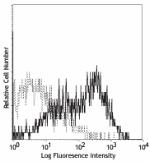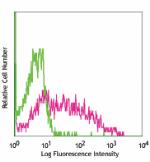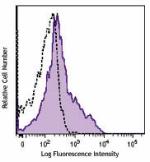- Clone
- mCD30.1 (See other available formats)
- Regulatory Status
- RUO
- Other Names
- Ber-H2, Ki-1, TNFRSF8
- Isotype
- Armenian Hamster IgG
- Ave. Rating
- Submit a Review
- Product Citations
- publications

-

Con A-stimulated (3 days)splenocytes stained with purified mCD30.1, then detected with biotinylated anti-Armenian hamster IgG followed by Sav-PE
| Cat # | Size | Price | Quantity Check Availability | Save | ||
|---|---|---|---|---|---|---|
| 102303 | 50 µg | 62€ | ||||
CD30 is a 105 kD type I transmembrane glycoprotein, also known as Ber-H2 or Ki-1. It is a member of the tumor necrosis factor receptor (TNFR) superfamily, expressed on activated T, B, and NK cells, and monocytes. CD28, in conjunction with several cytokines, regulates the expression of CD30 on activated T cells. It has been reported that cytokine production and Th1 versus Th2 development is heavily influenced by CD30-CD30 ligand (CD153) interactions.
Product DetailsProduct Details
- Verified Reactivity
- Mouse
- Antibody Type
- Monoclonal
- Host Species
- Armenian Hamster
- Immunogen
- Mouse CD30-mouse IgG1 fusion protein
- Formulation
- Phosphate-buffered solution, pH 7.2, containing 0.09% sodium azide.
- Preparation
- The antibody was purified by affinity chromatography, and conjugated with biotin under optimal conditions.
- Concentration
- 0.5 mg/ml
- Storage & Handling
- The antibody solution should be stored undiluted between 2°C and 8°C. Do not freeze.
- Application
-
FC - Quality tested
- Recommended Usage
-
Each lot of this antibody is quality control tested by immunofluorescent staining with flow cytometric analysis. For flow cytometric staining, the suggested use of this reagent is ≤1.0 µg per million cells in 100 µl volume. It is recommended that the reagent be titrated for optimal performance for each application.
- Application Notes
-
Additional reported applications (for the relevant formats) include: in vitro induction of IL-5 production1. For the most successful immunofluorescent staining results, it may be necessary to maximize signal over background by using a relatively bright fluorochrome-antibody conjugate (Cat. No. 102306) or by using a high sensitivity, three-layer staining technique (e.g., including a biotinylated antibody (Cat. No. 102304) or biotinylated anti-Armenian hamster IgG (Cat. No. 405501) second step, followed by SAv-PE (Cat. No. 405204)).
- Application References
-
- Bowen MA, et al. 1996. J. Immunol. 156:442.
- Punt JA, et al. 1997. J. Exp. Med. 186:1911.
- Product Citations
-
- RRID
-
AB_2240925 (BioLegend Cat. No. 102303)
Antigen Details
- Structure
- TNFR superfamily, 105-120 kD
- Distribution
-
Activated T cells, B cells and NK cells, monocytes
- Function
- Costimulation, regulates negative selection of thymocytes
- Ligand/Receptor
- CD153 (CD30L)
- Cell Type
- B cells, Embryonic Stem Cells, Monocytes, NK cells, T cells, Tregs
- Biology Area
- Immunology, Stem Cells
- Molecular Family
- CD Molecules
- Antigen References
-
1. Barclay A, et al. 1997. The Leukocyte Antigen FactsBook Academic Press.
2. Falini B, et al. 1995. Blood 85:1.
3. Gedrich RW, et al. 1996. J. Biol. Chem. 271:12852. - Gene ID
- 21941 View all products for this Gene ID
- UniProt
- View information about CD30 on UniProt.org
Related FAQs
- How many biotin molecules are per antibody structure?
- We don't routinely measure the number of biotins with our antibody products but the number of biotin molecules range from 3-6 molecules per antibody.
Other Formats
View All CD30 Reagents Request Custom Conjugation| Description | Clone | Applications |
|---|---|---|
| Biotin anti-mouse CD30 | mCD30.1 | FC |
| PE anti-mouse CD30 | mCD30.1 | FC |
| Purified anti-mouse CD30 | mCD30.1 | FC |
| APC anti-mouse CD30 | mCD30.1 | FC |
| TotalSeq™-C1062 anti-mouse CD30 | mCD30.1 | PG |
| TotalSeq™-B1062 anti-mouse CD30 Antibody | mCD30.1 | PG |
Compare Data Across All Formats
This data display is provided for general comparisons between formats.
Your actual data may vary due to variations in samples, target cells, instruments and their settings, staining conditions, and other factors.
If you need assistance with selecting the best format contact our expert technical support team.
-
Biotin anti-mouse CD30

Con A-stimulated (3 days)splenocytes stained with purified m... -
PE anti-mouse CD30

ConA-stimulated C57BL/6 splenocytes (Day 3) stained with mCD... -
Purified anti-mouse CD30

Con A-stimulated (3 days)splenocytes stained with purified m... -
APC anti-mouse CD30

Con A-stimulated (3 days) C57BL/6 mouse splenocytes were sta... -
TotalSeq™-C1062 anti-mouse CD30
-
TotalSeq™-B1062 anti-mouse CD30 Antibody
 Login / Register
Login / Register 










Follow Us